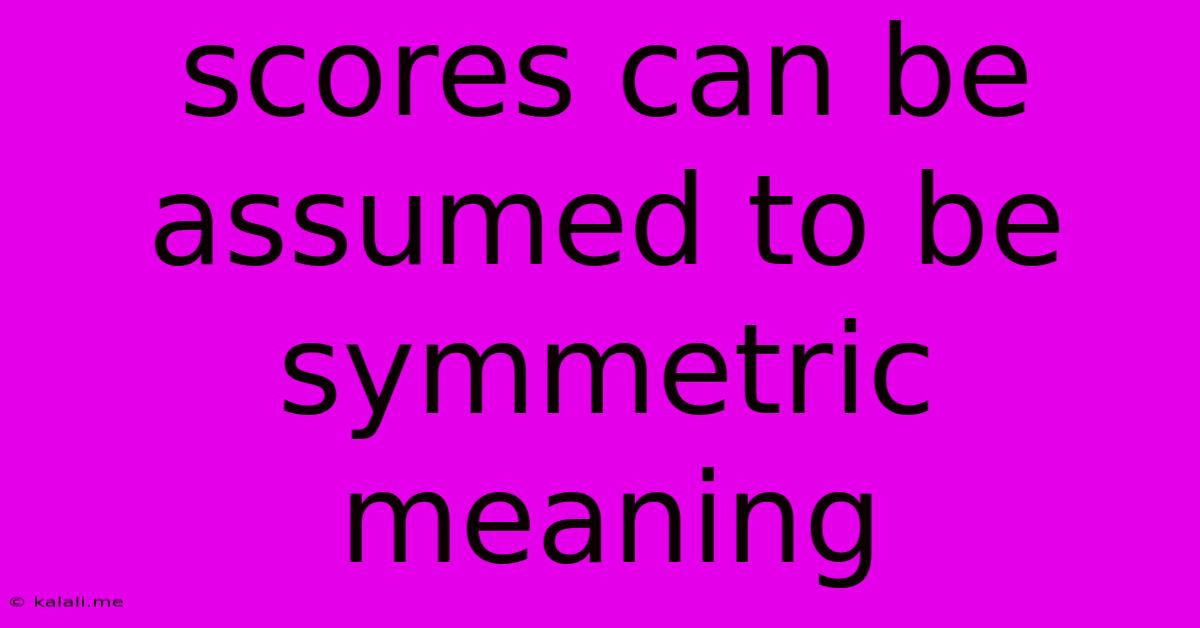Scores Can Be Assumed To Be Symmetric Meaning
Kalali
Jun 05, 2025 · 4 min read

Table of Contents
Scores Can Be Assumed to Be Symmetric: When and Why This Assumption Matters
This article delves into the crucial assumption of symmetry in statistical analysis, specifically focusing on score distributions. Understanding when this assumption holds and its implications is vital for accurate data interpretation and reliable conclusions. We'll explore the meaning of symmetrical scores, common scenarios where this assumption is valid (and invalid), and the consequences of violating it.
What Does it Mean for Scores to Be Symmetric?
A symmetrical distribution of scores means that the data is evenly distributed around its central tendency (usually the mean or median). Imagine a perfect bell curve: the left and right halves are mirror images of each other. In such a distribution, the mean, median, and mode are all equal. This symmetry implies that extreme scores at the high end are balanced by equally extreme scores at the low end. This characteristic is often assumed in many statistical tests and models.
When is the Assumption of Symmetric Scores Valid?
The validity of the symmetry assumption depends heavily on the nature of the data and the underlying phenomenon being measured. Here are some common scenarios where symmetric scores are often observed:
- Naturally Occurring Phenomena: Many natural processes result in approximately symmetrical distributions. Think of the heights of adult women or the IQ scores of a large population. While perfect symmetry is rare in real-world data, these often exhibit near-symmetry.
- Standardized Scores: Transformations like z-scores (standardization) can often make data more symmetrical, even if the original distribution was skewed. This normalization technique centers the data around a mean of 0 and a standard deviation of 1, sometimes reducing the impact of outliers and promoting symmetry.
- Large Sample Sizes: The Central Limit Theorem states that the distribution of sample means will tend towards normality (and thus symmetry) as the sample size increases, regardless of the shape of the original population distribution. This is a powerful tool, allowing for the use of parametric tests even with non-normal data if the sample size is sufficiently large.
When is the Assumption of Symmetric Scores Invalid?
It's crucial to recognize situations where the symmetry assumption is unlikely to hold:
- Skewed Distributions: Many real-world datasets exhibit skewness, meaning the data is concentrated more on one side of the mean than the other. Income distributions, for instance, are often right-skewed (a long tail to the right), with a few high earners significantly impacting the mean.
- Outliers: Extreme scores (outliers) can severely distort the symmetry of a distribution. A single outlier can pull the mean away from the median, making the distribution appear asymmetrical.
- Limited Range of Scores: If the scores are constrained within a narrow range, the distribution might appear symmetrical even if the underlying process is not symmetrical. For instance, scores on a perfectly-graded exam might look symmetrical, but this doesn't necessarily reflect underlying ability.
Consequences of Violating the Symmetry Assumption:
Assuming symmetry when it's not present can lead to several problems:
- Inaccurate Parameter Estimates: The mean can be a poor representation of the central tendency in skewed data. Using the mean when the median is more appropriate leads to biased estimates.
- Invalid Statistical Inference: Many statistical tests, particularly parametric tests (like t-tests and ANOVA), rely on the assumption of normality (which implies symmetry). Using these tests on non-symmetrical data can lead to incorrect p-values and potentially misleading conclusions.
- Misinterpretation of Results: Drawing conclusions based on the mean when the distribution is heavily skewed can be misleading, potentially misrepresenting the true nature of the data.
Conclusion:
The assumption of symmetric scores is a critical consideration in statistical analysis. While many real-world datasets show near-symmetry, or can be transformed to be more symmetrical, understanding the limitations of this assumption is essential. Carefully examine your data for skewness and outliers before applying any statistical tests that rely on this assumption. If symmetry is not present, consider using non-parametric tests which are less sensitive to the distribution's shape, or employing transformations to improve the symmetry of the data. Remember that data visualization techniques can be immensely useful in detecting any departure from symmetry.
Latest Posts
Latest Posts
-
Can Muslims Have Sex During Ramadan
Jun 06, 2025
-
Do You Speak Chinese In Chinese
Jun 06, 2025
-
Can I Put Vanilla Extract In My Coffee
Jun 06, 2025
-
Hoses Are Used When Movement Occurs Between Two Parts
Jun 06, 2025
-
How To Dry Clothes Without A Dryer
Jun 06, 2025
Related Post
Thank you for visiting our website which covers about Scores Can Be Assumed To Be Symmetric Meaning . We hope the information provided has been useful to you. Feel free to contact us if you have any questions or need further assistance. See you next time and don't miss to bookmark.